NOT TO PERISH: The Articles of an American Professor of Russian
by ASU professor Lee B. Croft and 12 students. January 2009. — Download $5 (3.3GB), Paperback book $30 – 299 pages, color. Preview book.The 13th article is an extensive update of news first reported here in April 2008: "First 'Russian Alphamagic Square' discovered by ASU professor and student." The Appendix shows, for the first time, the computer program written in a week by Samuel Comi, while a Russian student at ASU, to find the first Russian alphamagic squares.
The articles fascinate as they advance the reader's knowledge of: glossolalia, poetic decipherment and translation, language philosophy and psychology, linguistic iconicity and language universals, an American Nobel-laureate scientist's inspiration, literary pornography, pervasive triplicity, spontaneous human combustion and polylingual alphamagic squares.
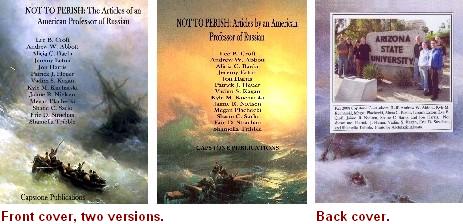
Citation:
Croft, Lee B. (1946--), Andrew W. Abbott, Alicia C. Baehr, Jeremy Ecton, Jon Harris, Patrick J. Heuer, Vadim S. Kagan, Kyle M. Kucharski, Jaime R. Nielsen, Megan Plachecki, Shane C. Sarlo, Eric D. Strachan, and Shamella Tribble. NOT TO PERISH: The Articles of an American Professor of Russian. Capstone Publications, Phoenix, AZ 85044 USA, 2009, 299 pp. il. ISBN 978-0-578-00468-6.
The book is available at Lulu.com/content/5400071.
Table of Contents (summaries
added)
| Foreword by Prof. Lee B. Croft | Page
5 |
|
| 1. |
“A Radical New Method of
Language Learning” by: Eric D. Strachan A published scientific hoax, claiming molecular memory transfer works and the Soviets can transfer language fluency from one prison-camp inmate to another with injections of cerebral spinal fluid. Croft invented a phoney 91% experimental success rate of language retention from electircal impulse induced hypnosis. Spoof translation of a hoax paper: "Synthetically Induced and Electrically Maintained Trance Glossolalia as a Method of Language Learning," by V.A. Obmanov [name means "liar, hoax" in Russian], Director of Research, Moscow Psycholinguistics Insitute. The Journal of Biological Psychology / The Worm Runner's Digest, Vol. XIV, #2, 1972. |
12 |
| 2. |
“Deciphering a Russian
Poem by Igor Chinnov” by: Megan Plachecki Analysis of a poem from Партитура, “Horses Fall into the Caspian Sea” (“Лошади впадают в Каспийское море”). This poem seems to mark a turning point in Chinnov’s poetry, and it demonstrates the power of poetry to convey specific meanings, which are virtually independent of literal statement. |
30 |
| 3. |
“Russian-to-English
Homographs” by: Andrew W. Abbott Conclusion: АТОМ, МАМА and ТОТЕМ are the only homographs which have the same meaning in both Russian and English. — From: "Russian-to-English Homographs in Ozhegov's Dictionary", WORD WAYS: The Journal of Recreational Linguistics, Vol. 8, No. 4 (Fall 1975). |
51 |
| 4. |
“Reality
and Truth in
Russian Grammar” by: Kyle M. Kucharski Spectral considerations of Factivity (concern with truth value) and Fictivity (concern with realizational status). Adaption of Prof. Croft’s 1973 Cornell University doctoral dissertation: "The Semantics of Modality in Russian Syntax”, read at the first conference on the Russian Language to unite language, linguistic, and language-pedagogy scholars from both the US and USSR, the Soviet-American Conference on the Russian Language (SACRL), Amherst and Cambridge, Massachusetts, October 1974 — "The expression of modality in English and Russian: a contastive analysis", Russian Language Journal (RLJ), Vol. XXIX (1979), No. 104, pp. 5-24. |
59 |
| 5. |
“An Early International
Example of Cinema’s Influence on Literature” by: Shamella Tribble Croft's 1971 Cornell University term paper was combined with data about 34 Chaplin films released in the USSR, to show that Chaplin influenced a Yuri Olesha film. — "Charlie Chaplin and Olesha's Envy", CLA Journal (The Official Quarterly Publication of the College Language Association), Vol. XXI (June 1978), No. 4, June. |
91 |
| 6. |
“Linguistics, Memory, and
Teaching” by: Shane C. Sarlo Croft's best scientific paper is about psycholinguistics, the way the mind stores language, showing mnemonic devices to aid teaching. — "The mnemonic use of lingustic iconicity in teaching language and literature", Slavic and East European Journal, Vol. 22 (1978), No. 4, p. 509-18. |
111 |
| 7. |
“Translating the Form as
Well as the Content” by: Jaime R. Nielsen Translated Alexander Pushkin’s 1814 poem in 1975, but published 20 years later. — "Pushkin's ‘Romance:’ A Translation Preserving Form", Hayden’s Ferry Review, #17, 1995. |
132 |
| 8. |
“Why Memorize?” by: Jeremy Ecton “Repetition is the mother of learning” , “Повторение-мать учения” — Paper: “The Neuromnemonic Case for Rote Memorization”, presented at the national convention of the American Association for the Advancement of Slavic Studies’ (AAASS), Slavic Languages Pedagogy section, Honolulu, Hawai’i, November 1993. Published in ASU text: “Why Memorize?—The Neuromnemonic Case for Rote Memorization", in Croft’s Russian Through Poems and Songs (now at Alternative Copy Center, Tempe, AZ ,1995, pp. 5-20). Published in Russia: "Нейромнемонический процесс заноминания через повтор” (“The Neuromnemonic Process of Memorization by Repetition”), Методика преподавания русского языка и литературы в Америке (Д. Филлипс, ред., Синтаксис, Москва, Россия, 1996, том 2, стр. 113-127). |
138 |
| 9. |
“The Professor and the
Pushkin Pornographer” by: Vadim S. Kagan A Russian émigré poet in Minneapolis created a scandal in 1986 by publishing Alexander Pushkin’s erotic “Secret Notes” from 1836-37. — "Review of Armalinsky, Mikhail. Вплотную... (“Close to…”). M.I.P. Company, Minneapolis, MN, 1994", World Literature Today, 69:4 (Autumn, 1995). |
157 |
| 10. |
“A Russian Biography of an
American Scientist” by: Patrick J. Heuer Translation of comemorative booklet honoring the prominent American scholar of physics, chemist, and 1932 Nobel laureate in chemistry. Associate Director, General Electric Research Laboratory 1909-1950. He was the father of high vacuum radio tubes, and gas-filled incandescent light bulbs; and pioneered flourescent lighting, hydrogen welding, wartime smoke screens, cloud seeding. He applied for 138 patents, granted 63. — "The Lad from Schenectady-Irving Langmuir", with Valentin F. Olontsev, Ural Division of the Russian Academy of Natural Sciences, 2001. |
169 |
| 11. |
“Putting Meaning into the
Memory” by: Alicia C. Baehr Unconscious associating sense and sound in language. —“Mnemonotactics and Linguistic Iconicity”, The Learning and Teaching of Slavic Languages and Cultures, 2000. Also: “Опыт мнемонического использования лингвистической образности” (“Testing the Mnemonic Utility of Linguistic Iconicity” with P.B. Cossette, Методика преподавания русского языка и литературы в Америке (“The Methodology of Teaching Russian Language and Literature in America”) |
184 |
| 12. |
“Why so Many Threes” by: Jon Harris Mentally why Russians like things in threes, in literature and culture. — “People in Threes Going Up in Smoke and Other Triplicities in Russian Literature and Culture,” Rocky Mountain Review of Language and Literature, Vol. 59 (Fall 2005), Number 2, pp. 29-49. Also: "Triplicity and Textual Iconicity: Russian Literature Through a Triangular Prism," Syntactic Iconicity and Linguistic Freezes: The Human Dimension. 1995. pp. 249-265. |
203 |
| 13. |
“The Magic of Alphamagic
Squares” by: Lee B. Croft Alphamagic squares shown for 14 languages and at least 3 alphabets: English, Rusian, French, Italian, German, Spanish, Hungarian, adding Albanian, Armenian, Bosnian-Croatian- Serbian, Polish, Tajik, Tatar, and Uzbek. — "The Search for Russian Alphamagic Squares and Their Translations" is and update of the April 2008 news: "First 'Russian Alphamagic Square' discovered by ASU professor and student." Croft, Lee B. and Comi, Samuel. (2008) “Russian Alphamagic Squares” in Word Ways: The Journal of Recreational Linguistics, Vol. 41, No. 2 (May 2008), pp. 95-100. Croft, Lee B. and Comi, Samuel. “A Fourth-Order, Digitally-Reversible, Polylingual, Bialphabetic Alphamagic Square.” Journal of Recreational Mathematics. Vol 34, No. 3 (2005-2006), pp. 247-257. |
238 |
| 14. |
Appendix: “A Javascript
Computer Program to Generate Third-order Russian Alphamagic Squares” by: Samuel Comi Shown for the first time is this computer program written in a week to find the first Russian alphamagic squares. See April 2008 news: "First 'Russian Alphamagic Square' discovered by ASU professor and student." |
288 |
| 15. |
PROLOGUE: “What Have We
Learned” "... producing published scholarship is WORK ... Don’t ask ‘Why do I have to know this?’. We want to KNOW EVERYTHING." |
296 |
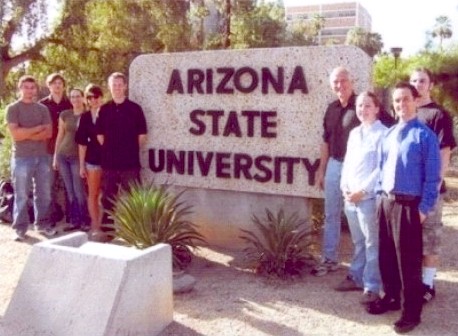 Fall
2008 Capstone Co-Authors: (L-R) Andrew W. Abbott, Kyle M. Kucharski,
Megan Plachecki, Alicia C. Baehr, Jeremy Ecton, Lee B. Croft, Jaime R.
Nielsen, Shane C. Sarlo, and Jon Harris. Not shown are: Patrick J.
Heuer, Vadim S. Kagan, Eric D. Strachan, and Shamella Tribble. Photo by
Abdulaziz Alossta.
Fall
2008 Capstone Co-Authors: (L-R) Andrew W. Abbott, Kyle M. Kucharski,
Megan Plachecki, Alicia C. Baehr, Jeremy Ecton, Lee B. Croft, Jaime R.
Nielsen, Shane C. Sarlo, and Jon Harris. Not shown are: Patrick J.
Heuer, Vadim S. Kagan, Eric D. Strachan, and Shamella Tribble. Photo by
Abdulaziz Alossta.Foreword
By: Lee B. CroftFor its students subject to the 2005-and-newer catalogues, Arizona State University has adopted a policy requiring its graduating seniors to complete a “capstone project” in their final year of study. The capstone project is supposed to pair these advanced students with a senior professor in their field of major and require that they, under the professor’s direction, engage in some project of value to them that utilizes the knowledge, attitudes, and skills they have gained in the course of their undergraduate work. Many others of our nation’s leading universities have also adopted such a capstone requirement in the past five years, so that university professors all over the land are now grappling with the task of deciding “what to do” with their students as a worthy capstone project. This foreword describes what I have done, being now, after thirty-five years here, the Senior Professor of Russian at ASU and Head of its Faculty of German, Romanian, and Slavic Letters and Cultures.
As my first crop of Russian BA-program seniors encountered this new requirement in the fall of 2006, I decided that, utilizing our hard-earned research, writing, and polylingual, polyalphabetic word processing skills, we should conceive, write, edit, and publish a book together. That way the students would finish their undergraduate academic careers having a co-authored book to their credit in seeking future career opportunities. And, of course, I thought that they would learn much about the entire process of publishing…something that I had learned as a consequence of being a major university professor and having to “publish or perish” in order to stay one. The first capstone project in our ASU Russian BA program involved four seniors, Barry Boosman, Kathryn Lutz, James C. Nielsen, and Aimee M. Raymer, in a project to publish a comprehensive history of our program itself—a pioneering
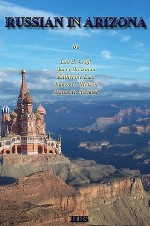 “programography” as
it were, entitled RUSSIAN IN
ARIZONA: A History
of Its Teaching. It was a very ambitious project, attempting to
feature EVERY person who had EVER taught Russian ANYWHERE in the State
of Arizona, as well as a large share of the students who took it as a
subject from the birth of Russian instruction in the state at ASU in
1946 to the present day. Published by the triorganizational
collaborative Institute for Issues in the History of Science of Tempe,
Arizona and Perm, Russian Federation, in 2007 (ISBN 978-1-4303-2355-6),
it includes mention of over 1600 people, with sixty photos, charts,
graphs, and other illustrations in its 260 pages…see Andrew John
Conovaloff’s website, www.Russianaz.org,
under “sponsors” for THREE
ways to order it. The book’s award-nominated cover shows the iconic St.
Basil’s Cathedral on Moscow’s Red Square transplanted precariously onto
a cliff of Arizona’s iconic Grand Canyon…a precariousness of perch that
is, in my view, entirely iconic itself to the situation of the state’s
Russian programs in its educational apparatus. My four student
co-authors and I took tw o semesters to produce it, even though the
students were only registered in the capstone project as a one-semester
course. We worked our behinds off, interviewing people, photographing
people, writing, editing and producing this book. We are proud of it
and feel that we’ve done something novel and important. Our Prof.
Emeritus S. C. Couch, featured in the book as a “large figure” in the
history of the teaching of Russian in the State of Arizona, commented
to me that he found the book “Monumental.” That’s just the right word
for it, in my opinion. Certainly it affirms my own legacy here and may
constitute my own career “capstone project.”
“programography” as
it were, entitled RUSSIAN IN
ARIZONA: A History
of Its Teaching. It was a very ambitious project, attempting to
feature EVERY person who had EVER taught Russian ANYWHERE in the State
of Arizona, as well as a large share of the students who took it as a
subject from the birth of Russian instruction in the state at ASU in
1946 to the present day. Published by the triorganizational
collaborative Institute for Issues in the History of Science of Tempe,
Arizona and Perm, Russian Federation, in 2007 (ISBN 978-1-4303-2355-6),
it includes mention of over 1600 people, with sixty photos, charts,
graphs, and other illustrations in its 260 pages…see Andrew John
Conovaloff’s website, www.Russianaz.org,
under “sponsors” for THREE
ways to order it. The book’s award-nominated cover shows the iconic St.
Basil’s Cathedral on Moscow’s Red Square transplanted precariously onto
a cliff of Arizona’s iconic Grand Canyon…a precariousness of perch that
is, in my view, entirely iconic itself to the situation of the state’s
Russian programs in its educational apparatus. My four student
co-authors and I took tw o semesters to produce it, even though the
students were only registered in the capstone project as a one-semester
course. We worked our behinds off, interviewing people, photographing
people, writing, editing and producing this book. We are proud of it
and feel that we’ve done something novel and important. Our Prof.
Emeritus S. C. Couch, featured in the book as a “large figure” in the
history of the teaching of Russian in the State of Arizona, commented
to me that he found the book “Monumental.” That’s just the right word
for it, in my opinion. Certainly it affirms my own legacy here and may
constitute my own career “capstone project.”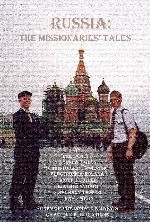 In the fall of 2007
I had another crop of seniors register into the
RUS-498 capstone project, and this crop was almost DOUBLE the size of
the former. Six students—Andrew T. Gunn, Electronica Kolasa, Scott C.
Legler, Heather Nyhart, S. Zachary Tanner, and Travis Webb, joined
former student Christopher D. Johnson with me in a project to publish a
book entitled RUSSIA:
The Missionaries’ Tales. This book, to which Prof
Emeritus of Russian at Brigham Young University Donald K. Jarvis
contributed a wonderful foreword, is an anthology of stories of the
missionaries of the Church of Jesus Christ of Latter Day Saints’ (LDS,
or “Mormons”) personal and linguistic adaptation to the Russian culture
while on their two-year missions there. The authorial team, five of
whom (but not I) are returned LDS Russian missionaries themselves (as
are more than one-third of my graduating seniors in Russian for the
past decade) contacted over 200 former LDS Russian missionaries, urging
them to submit the constituent “tales.” Forty tales were eventually
published in the book in summer of 2008. We decided as a group (in the
spirit of entrepreneurship that I always try to encourage in my
students) to publish it ourselves under the imprimature of a new
company we formed together called CAPSTONE Publications (11622 S.
Tusayan Court, Phoenix, AZ. 85044…my home address). This book, ISBN
978-1-4357- 1264-5, can also be ordered in THREE ways (color-photo
“Presentation” edition, black-and-white-photo “Market” edition, or
color-photo edition download in pdf. without the cover for only
$5.00…again see Andrew John Conovaloff’s website www.Russianaz.org
under “sponsors” for a nice
feature about the book, including the Table
of Contents and hyperlinks to the online digital printer www.lulu.com
to place an order most economically).
In the fall of 2007
I had another crop of seniors register into the
RUS-498 capstone project, and this crop was almost DOUBLE the size of
the former. Six students—Andrew T. Gunn, Electronica Kolasa, Scott C.
Legler, Heather Nyhart, S. Zachary Tanner, and Travis Webb, joined
former student Christopher D. Johnson with me in a project to publish a
book entitled RUSSIA:
The Missionaries’ Tales. This book, to which Prof
Emeritus of Russian at Brigham Young University Donald K. Jarvis
contributed a wonderful foreword, is an anthology of stories of the
missionaries of the Church of Jesus Christ of Latter Day Saints’ (LDS,
or “Mormons”) personal and linguistic adaptation to the Russian culture
while on their two-year missions there. The authorial team, five of
whom (but not I) are returned LDS Russian missionaries themselves (as
are more than one-third of my graduating seniors in Russian for the
past decade) contacted over 200 former LDS Russian missionaries, urging
them to submit the constituent “tales.” Forty tales were eventually
published in the book in summer of 2008. We decided as a group (in the
spirit of entrepreneurship that I always try to encourage in my
students) to publish it ourselves under the imprimature of a new
company we formed together called CAPSTONE Publications (11622 S.
Tusayan Court, Phoenix, AZ. 85044…my home address). This book, ISBN
978-1-4357- 1264-5, can also be ordered in THREE ways (color-photo
“Presentation” edition, black-and-white-photo “Market” edition, or
color-photo edition download in pdf. without the cover for only
$5.00…again see Andrew John Conovaloff’s website www.Russianaz.org
under “sponsors” for a nice
feature about the book, including the Table
of Contents and hyperlinks to the online digital printer www.lulu.com
to place an order most economically).Given the effort involved in producing two books in two years while doing everything else long required in this position, you can understand my trepidation at having TWELVE Russian BA seniors (see the title page, of course) register for the RUS-498 Capstone course this Fall of 2008 semester. As I have explained, the precedent of publishing a book together had been set by the two former efforts…and was indeed a big part of the reason why so many sought registration in the course (some could have escaped the requirement by writing an undergraduate honors thesis…a two-semester project credited under RUS-492 and RUS- 493…but they preferred to participate in this capstone project). But what kind of book could positively involve thirteen co-authors (me included) in the learning process as they produced a book together? We discussed several possibilities—writing an anthology of anecdotes from former students under the title “Where are they now?” with each co-author being responsible for contacting an agreed upon number of alumni (perhaps a future project, eh?); putting together a photo album of pictures of Russia taken by those students who had been in Russia during the course of their study (another future book?); and several others. But at last I found consensus in the publication of this anthology of thirteen (I hope it isn’t an unlucky number for us) of my previously published scholarly articles, with each of the co-authors presenting the articles’ publicational circumstances, scholarly impact in subsequent citations, etc. The title, Not to Perish: The Articles of an American Professor of Russian, makes reference to the dictum “publish or perish” mentioned earlier. In this way each student becomes, as a result of this process, not only a coauthor of the whole book itself, but a sole author of the included article of presentation under a separate title (as well as a share-holder in any publication revenues from their publisher CAPSTONE Publications…may we all get rich!). My hope is that the reader finds these articles and their presentations interesting. They are, I think, strikingly diverse in topic and approach and will give the reader “something completely different” (as the Monty Python absurdist comedy group used to say) to think about. I admit to choosing works of a certain quirky appeal: “Synthetically Induced and Electrically Maintained Trance Glossolalia as a Method of Language Learning,” (Now just WHAT is that, eh?); “Russian-to-English Homographs in Ozhegov’s Dictionary” (newly significant in the internet age); and “Thrice to Tell the Tale: People in Threes Going Up in Smoke and Other Triplicities in Russian Literature and Culture” (Spontaneous Human Combustion yet…and tripled in the telling to boot). All are presented (“translated,” as it were, actually or virtually) by the individual co-authors so that the lay reader (particularly those without knowledge of Russian) can understand and, hopefully, enjoy them.
If you read my curriculum vitae you will see that I have always tried to involve my students into my own publication ventures. More than fifty are mentioned as co-authors or published contributors to my works—books, articles, or talks and scholarly presentations. This is, to me, an integral part of what being a “professor” is about. Teaching and mentorship is what is paramount in this profession, in my view. But that is not all. Research, writing, and publication are the avenues by which we “profess” what we learn, what we know. And professors have to teach this too. That is what this book …our capstone project…is about. Here we are all “professors,” only some for the first time.
— Lee B. Croft
Phoenix, AZ
October 12, 2008
| Click
images to enlarge cover versions: |
|
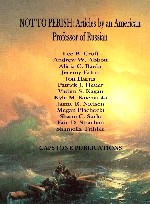 |
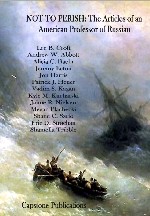 |
- Preview 12 pages of Not to Perish.
- See Dr. Croft's summaries of his 6 books
- More Books at Lulu.com by Dr. Lee Croft and ASU students.
For more information contact Lee.Croft@ASU.EDU:
Lee B. Croft,
Ph.D.
Senior Professor of Russian
Head, Faculty of German, Romanian, and Slavic (GRS)
School of International Letters and Cultures (SILC)
ASU, Tempe, AZ 85287-0202
Senior Professor of Russian
Head, Faculty of German, Romanian, and Slavic (GRS)
School of International Letters and Cultures (SILC)
ASU, Tempe, AZ 85287-0202